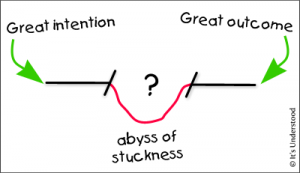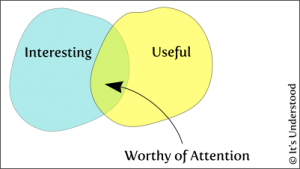by Andrew | Sep 21, 2010 | Build your own skills, Get people talking |
 Have you ever encountered a group meeting; brainstorming, retrospective or other variety that was simply dominated by an outspoken minority? This often happens despite the best intentions and efforts of the meeting chairperson or facilitator. The result can be a fairly predictable set of proposals that rarely stretch any boundaries. In his book “Think Better” Tim Thurson calls this unfortunate result “braindrizzle”.
Have you ever encountered a group meeting; brainstorming, retrospective or other variety that was simply dominated by an outspoken minority? This often happens despite the best intentions and efforts of the meeting chairperson or facilitator. The result can be a fairly predictable set of proposals that rarely stretch any boundaries. In his book “Think Better” Tim Thurson calls this unfortunate result “braindrizzle”.
The likelihood of this dilemma is higher self-organizing teams where a facilitator role is absent. And the risk of skewed participation in a mixed group of introverts and extroverts in this case is even greater. Recently, project management consultant Johanna Rothman said, “It only takes one extrovert to kill a team of introverts.” How then to ensure the best thoughts of all team members are aired?
Not everyone is comfortable with the open outcry methods of traditional brainstorming techniques – least of all, those of us who prefer some time for reflection. “Brainwriting” – the silent cousin to “brainstorming” – is an important and useful technique that gives everyone equal opportunity to contribute their thoughts. It overcomes the “social disadvantage” on the part of introverts by ensuring the loudest (or most glib) voices don’t prevail in a group discussion. The added time to reflect on suggestions is a boon to introverts without stifling extroverted inclinations to be heard. We can easily adopt this process without cost or strain.
(more…)
by Andrew | Sep 20, 2010 | Build your own skills, Rants, Ramblings and Riddles |
 The number one killer of great outcomes is being stuck between “saying” and “doing.” Because I’ve been prone to this particular dysfunction, I’ve collected a vast assortment of observations that addresses the painfully obvious gap between intention and outcome. There are many reasons for the gap. Most have their roots in some degree of fear: failure, ridicule, scorn, criticism…name your pet fear. Many introverts, who have advanced skills in negative self-talk (not a good thing), are adept at getting stuck. If talking yourself out of doing thing things is a common experience for you, I highly recommend reading Dr. Rick Carlson’s classic “Taming Your Gremlin” which offers pithy and useful advice on this front.
The number one killer of great outcomes is being stuck between “saying” and “doing.” Because I’ve been prone to this particular dysfunction, I’ve collected a vast assortment of observations that addresses the painfully obvious gap between intention and outcome. There are many reasons for the gap. Most have their roots in some degree of fear: failure, ridicule, scorn, criticism…name your pet fear. Many introverts, who have advanced skills in negative self-talk (not a good thing), are adept at getting stuck. If talking yourself out of doing thing things is a common experience for you, I highly recommend reading Dr. Rick Carlson’s classic “Taming Your Gremlin” which offers pithy and useful advice on this front.
Seth Godin writes frequently and fiercely on the subject of getting out of your own way. His recent post, “The Myth of Preparation” is a call to action for all of us who hesitate to put our ideas into the world until they are perfect. And his short but powerful book “The Dip” focuses on the inevitable challenges in pursuing new ventures to completion.
There are useful lessons to be learned from Agile methods of software development: Chunk work into manageable portions, strive for the minimum value proposition, ship (i.e., get it out there) and repeat. Iteration and accumulation of usefulness goes a long way to overcoming the delays imposed by attempting to design the perfect complete thing before acting.
If design is not your issue but mastery (and it’s sidekick, credibility) I suggest we listen to Seth and get over it. Here’s an idea worth repeating frequently to calm your misgivings :
“Anything worth doing is worth doing poorly–until you can learn to do it well.” — Zig Ziglar
Ideas only have value when acted upon. Commitments to yourself and, especially, others without action are beyond unhelpful. Being stuck in inaction furthers no one’s cause. So do something about whatever is on your mind, however small. It would be a start, bridge that gap and get you closer to the outcome you desire.
by Andrew | Sep 14, 2010 | Build your own skills, Rants, Ramblings and Riddles |
Attention, focused and conscious thought, is a scarce resource. It requires effort and consumes energy – something our brains strive to minimize.
It’s further constrained by the number of waking hours we have. We only have so much time in which to express ourselves and do things that matter. Yet, without fail, a multitude of things manage to distract us from the things we really want to achieve.
In today’s “always on” environment these distractions seem to multiply and the opportunity to dilute our attention is usually only a click away. There are so many sources of practical advice on how to focus, from time management practices to “Getting Things Done” frameworks, that it seems we have no excuse to be distracted – but it happens.
How then to decide what to do? Here’s an interesting question to ask yourself before (or while) you disappear down a rabbit hole following a unplanned thread of activity: “Is this interesting or is this useful?”
I happen to be interested in many things and love to explore ideas and connections between them. My wife and business partner calls me an “info lush.” This is highly entertaining (for me) and sometimes yields useful discoveries or insights, yet it’s often dysfunctional in the broader context of life.
 What, then, is worthy of our attention? Or, more to the point, the attention of folks you want to help. Clearly the intersection of these two sets, the interesting and the useful, is where we should focus.
What, then, is worthy of our attention? Or, more to the point, the attention of folks you want to help. Clearly the intersection of these two sets, the interesting and the useful, is where we should focus.
I know it’s difficult at times to place ourselves on the “interesting versus useful” scale, but simply being mindful of the distinction and and asking the question can us help decide where to spend our most precious resource – our attention.
If we take this economic view, we can decide to spend our limited attention resource where it will have the greatest return. Isn’t that a worthy goal?
by Andrew | Sep 1, 2010 | Build your own skills, Rants, Ramblings and Riddles |
 If you’re like me, at least a little bit, you want to know why stuff works. I’ve a long history of pulling things apart to see what makes them tick. It’s just something I need to do. I can appreciate magic but I can’t help thinking of an explanation for the effect. Perhaps you do too.
If you’re like me, at least a little bit, you want to know why stuff works. I’ve a long history of pulling things apart to see what makes them tick. It’s just something I need to do. I can appreciate magic but I can’t help thinking of an explanation for the effect. Perhaps you do too.
That’s why I was initially a bit sceptical about coaching. I know there are lots of great true-to-life examples of coaching success, especially from the sports world. Which great Olympian doesn’t have a coach? And team sports just wouldn’t be the same or, perhaps exist, without the Coach alongside the players. So why the hesitation?
I just had to have a framework, some foundation, to understand why a coach isn’t simply an expensive nag. Well I found it when I started to explore the neuroscience-based approach taken by David Rock. He’s built on relatively recent discoveries about how our brains actually work to construct a coaching model and process that takes advantage of our innate behaviour to instill new thoughts and habits without undue pain and stress.
(more…)
by Susan Johnston | Feb 18, 2007 | Build your own skills, Get people talking |

I have invested far too many hours, this weekend, trying to sort out a communication mess. A member of a volunteer board, on which I serve, has, effectively punched the rest of us in the head.
We probably deserve it.
There are sins of commission and sins of omission. Both forms are present on both sides of this particular communication mess.
The sin commtted is that of working up a good sense of outrage, sending off the e-mail equivalent of a nuclear attack on the entire world, and sitting back to watch the explosion.
I confess. In my younger, stupider days, I committed that very sin, myself, though on a smaller scale (and using cleaner, crisper, clearer language). I loved being outraged and articulate about it. Later, I became a journalist, and was paid to commit that sin.
In the situation this group faces, today, it’s the sins of omission that are more disturbing.
(more…)
by Susan Johnston | Apr 7, 2006 | Build your own skills |
 In the past few months (make that years) I’ve read everything I can on the topic of leadership. Several bifocal prescriptions later, I know qualify for guru status.
In the past few months (make that years) I’ve read everything I can on the topic of leadership. Several bifocal prescriptions later, I know qualify for guru status.
Ostensibly, I’m gathering information that can help my clients. And I’m doing research for my own book. But mostly, I’m hunting for the elusive key that will unlock the mysteries I face daily in being a leader myself.
As I stand before the great wall of leadership titles at my local Chapters store, I wonder if there is anything more to be said on the topic.
There are books that will show us how to lead from the back, the middle or the front. They’ll teach us how to lead like Jesus, Einstein, Colin Powell, Billy Graham, Attila the Hun, or even Harry Potter. Authors share their laws of leadership and secrets of success, which (oddly?) always appear in uneven numbers. Unless there are 10. Speaking of numbers, these titles tell us to run our business by the numbers – or not to take the numbers too seriously, depending on the author. Some of them wisely tell us not to take ourselves too seriously.
My reading has led me to the following conclusions:
- I lead from where I am. Back, middle, front, top, or bottom – it really doesn’t matter. Your location in the organizational hierarchy or political pecking order is unimportant. Lead from where you are, even if it’s the garage.
- I lead like myself. I’ll bet you noticed you’re not Einstein or Harry Potter. You have to find the leadership style that fits you. And you can. There is no secret formula. All those who dispense leadership advice, including me, can do no more than spark your imagination and point you in a direction for experimentation. Watch yourself in action. See what works. Change what doesn’t. Here’s where Einstein comes in. He’s the one who said doing the same thing over and over again and expecting different results is insanity.
- There is one law of leadership: Treat people like people. Respect their humanity. Demonstrate empathy. Acknowledge their contribution. If we treat people as “resources,” just raw materials in the corporate success mix, they will know it. I used to work for an executive who barely knew who I was, let alone what I did. I felt I was indistinguishable from the photocopier and made weekly updates to my résumé. His successor asked my opinions, took my advice, shared his dreams, knew mine, and made me feel honoured to be part of his organization. For the first man, I worked hard. For the second, I worked well.
- There is a corollary to the one law: Show them you’re human, too. Acknowledge your own imperfections. I know a man whose motto is “Flaunt your quirks.” That may be further than most of us are willing to go. But showing your own humanity is attractive. We’re working with smart people. They know we’re not perfect. Why pretend to have all the answers? A willingness to be vulnerable can be disarming.
- I lead myself before I lead others. The days when “Do as I say not as I do” was an effective leadership tactic ended before we were born. We don’t need to be perfect, yet we do need to be awake and aware of our behaviours and our interactions.
- Taking myself seriously will make me crazy and wreck my business. Seriously, we have to lighten up. Take your business seriously. Take your relationships seriously. Take the hockey playoffs seriously (if you must). But take yourself seriously and, next thing you know, you’re on the nasty path to self-absorption, listening to ego, and losing your focus. Plus people will hide when they see you coming.
So what’s my point? Maybe what the business press calls “leadership” is really better described as “interpersonal effectiveness.” Leadership is no longer about getting people to line up behind you, follow you up the hill like good soldiers, and obey your commands. Leadership today means aligning diverse people to work on common projects to meet individual needs that may or may not overlap. As individuals, interacting with and relating to other individuals, we determine the outcome.
Field work: Notice. In your interactions with people, observe your habits. Do you really see them as people? Do you let them see you that way?
 Have you ever encountered a group meeting; brainstorming, retrospective or other variety that was simply dominated by an outspoken minority? This often happens despite the best intentions and efforts of the meeting chairperson or facilitator. The result can be a fairly predictable set of proposals that rarely stretch any boundaries. In his book “Think Better” Tim Thurson calls this unfortunate result “braindrizzle”.
Have you ever encountered a group meeting; brainstorming, retrospective or other variety that was simply dominated by an outspoken minority? This often happens despite the best intentions and efforts of the meeting chairperson or facilitator. The result can be a fairly predictable set of proposals that rarely stretch any boundaries. In his book “Think Better” Tim Thurson calls this unfortunate result “braindrizzle”.




 In the past few months (make that years) I’ve read everything I can on the topic of leadership. Several bifocal prescriptions later, I know qualify for guru status.
In the past few months (make that years) I’ve read everything I can on the topic of leadership. Several bifocal prescriptions later, I know qualify for guru status.